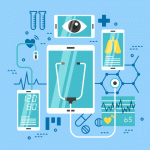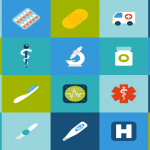While patients and healthcare organizations used to have little say in the doctors providing virtual care, today’s hospitals, clinics and private practices are offering their own virtual care solutions that can connect patients to the doctors of their choosing.
You ask someone to describe a typical telehealth visit, they’ll probably imagine a Direct-to-Consumer (DTC) experience. The patient dials up a telemedicine app and connects to a doctor-of-the day who then addresses a common ailment like an ear infection or the flu. If lucky, the patient might even have a video call with Dr. Doe who then prescribes a Z-Pack – based on no actual evidence, of course, only symptoms described by the patient. Or someone may envision a hospital stay where a patient is routed to a virtual exam room to be connected to an external physician from outside the hospital network.
But DTC is quickly becoming the less dominant and desirable telemedicine model. While patients and healthcare organizations used to have little say in the doctors providing virtual care, today’s hospitals, clinics and private practices are offering their own virtual care solutions that can connect patients to the doctors of their choosing. Hospitals that previously outsourced care to relieve their own overburdened staff are now insourcing – creating connected care programs that provide telemedicine within the patient’s existing healthcare circle instead of forcing them outside of it.
10 Reasons Telehealth Is Insourced
Want to publish your own articles on DistilINFO Publications?
Send us an email, we will get in touch with you.
Telemedicine has come a long way from the days of simple telephone or video calls. Today’s advanced solutions offer complete platforms of sophisticated hardware, integrative software and data-connected devices such as HD cameras, ultrasounds and stethoscopes. Unlike DTC consults, today’s solutions also allow providers to collect medical evidence and add it to the patient’s health history.
By offering their own in-house solutions, hospitals and clinics are finding renewed abilities to:
- Manage capacity. For a while now, hospitals have turned to virtual services to balance provider workloads and to offer remote intensivist and specialist consultations without paying full-time staff physicians. But they’ve found that outsourcing services to strangers has risked their reputation and patient outcomes. Now administrators are using their own providers for virtual visits to reduce readmissions, relieve crowded ER waiting rooms and redistribute patient needs across facilities.
- Attract and retain patients. Millennials and Generation Z are actively seeking virtual care from their providers, with 74% preferring telemedicine visits to in-person appointments. Raised on a diet of “appified” customer service experiences, patients under 40 want immediacy and convenience from their healthcare experience – and are choosing providers based on those factors.
- Reach the underserved. Hospitals are partnering with other care delivery providers such as school-based health centers to help students who lack other access to care and rural clinics that lack specialized medical expertise in their community, like addiction treatment counselors or infectious disease specialists. These programs can also eliminate long travel times for annual exams and preventive screenings, helping patients receive timely care and avoid more complex treatment for advanced conditions.
- Assist fragile patients. From elderly patients who have trouble attending in-office appointments to neonatal infants who may need immediate specialty intervention, telemedicine is the most seamless delivery model to provide real-time care no matter where patients or providers are located.
- Improve care coordination. Healthcare today can feel chaotic with the mix of providers and facilities and medications that flow through a patient’s life. Organizations are using telemedicine at the right touchpoints inpatient care journeys to spot evolving issues and possible drug interactions, accelerate interventions, offer smarter care coordination and collaborate with other providers. This greater visibility also offers clinicians deeper insights into their patients’ social determinants of health and behavioral challenges.
- Offer faster care and smarter triage. Those first minutes after a heart attack or stroke are critical – and paramedics are making the most of them by using telemedicine to consult with doctors while treating patients in their homes. Lower-acuity patients can also virtually consult physicians to determine if they actually need an office or ER visit, which frees up exam rooms for patients with truly urgent issues.
- Improve community health. Many healthcare organizations are using virtual care to extend their community presence and bring care directly to the patient. Mobile health clinics offer flu vaccines, skin cancer screenings and other preventive care in specific neighborhoods to improve population health outcomes. Some hospitals operate telemedicine programs for local jails and prisons to provide inmates with care while keeping them incarcerated and out of hospital exam rooms. Telebehavioral health programs can also appeal to patients reluctant to be seen visiting the local psychiatric clinic.
- Remote Patient Monitoring (RPM). Many providers are using RPM to provide post-acute care after hospitalization and surgical procedures. RPM can also improve outcomes for patients with chronic conditions, such as diabetes, heart disease, hypertension and chronic obstructive pulmonary disease by promoting consistent monitoring and timely interventions that can keep them out of the hospital.
- Create new revenue streams. Private practices are driving revenue by seeing a higher number of patients, reducing no-shows and offering extended service hours for patients who would otherwise go to an urgent care clinic. Providers can also refer patients within their network through more specialist options or by holding specialty consults while the patient is still in the office during the initial appointment.
- Improve physician recruitment and retention. With the U.S. provider shortage expected to reach 90,000 doctors by 2025, hospitals are looking for new ways to recruit and retain physicians. Telemedicine’s ability to offer flexible appointment hours and help providers work from home can make hospitals appealing to prospective hires; physicians can see patients from a wider geographic service area without needing to drive to different clinics and hospitals every day, relieving burnout.
Higher Efficiency, Stronger Patient Outcomes
Telehealth has long been lauded for putting the right patient in front of the right clinician at the right time. Now that virtual care has proven its clinical and economic value, healthcare leaders are realizing that driving the biggest rewards from telemedicine requires the smartest strategies. By imposing more control over connected care programs and using their own clinicians, these leaders are offering a better healthcare experience for providers and patients – and better health for their communities.
Source: MedCity News








